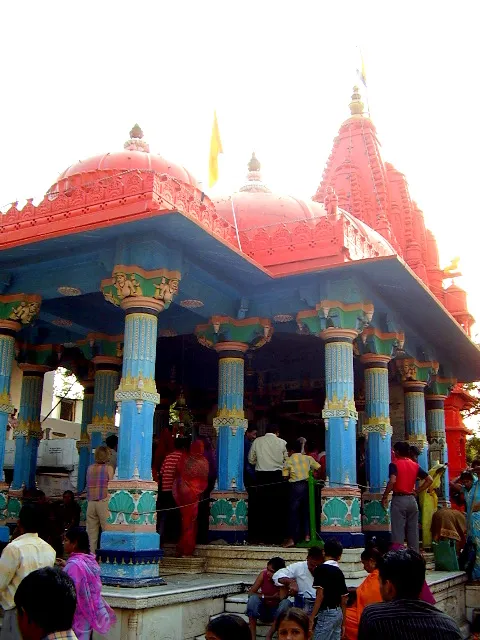
Brahma Temple, Pushkar: A Sacred Pilgrimage Destination
The Brahma Temple in Pushkar, Rajasthan, is one of the most revered Hindu temples dedicated to Lord Brahma, the creator deity in the Hindu Trinity (Trimurti). This ancient temple holds a special place in Hinduism due to its unique dedication to Brahma and its rich historical and spiritual significance.
Location and Historical Context
- Location: Pushkar, Rajasthan, India
- Historical Context: Pushkar is a historic town known for its numerous temples and spiritual significance. The Brahma Temple is one of the few temples in India dedicated solely to Lord Brahma. It is believed to have been built during the 14th century, though the site itself is much older and steeped in ancient traditions.
Architectural and Design Features
1. Architectural Style
Traditional Temple Architecture: The Brahma Temple features traditional Rajasthani temple architecture with a focus on simplicity and spiritual elegance. It combines elements of medieval Hindu temple design with local artistic influences.
Materials: Constructed primarily of marble, the temple showcases intricate carvings and decorative elements typical of Rajput architecture. The use of marble adds to the temple’s aesthetic appeal and longevity.
2. Main Shrine
Deity Representation: The central shrine of the Brahma Temple houses the idol of Lord Brahma, depicted with four heads, symbolizing his role as the creator of the universe. The idol is adorned with flowers, offerings, and traditional decorations.
Intricate Carvings: The temple’s walls and entrance feature detailed carvings and sculptures depicting various Hindu deities, mythological scenes, and geometric patterns. These carvings enhance the temple’s spiritual atmosphere and artistic charm.
3. Temple Complex
Prayer Hall: The temple includes a prayer hall where devotees gather for worship and ceremonies. The hall is designed to accommodate visitors and provide a serene space for prayer and reflection.
Surrounding Environment: The temple is situated near the sacred Pushkar Lake, adding to its spiritual significance. The surrounding area is characterized by a tranquil atmosphere and is often bustling with pilgrims and visitors.
Cultural and Spiritual Significance
1. Spiritual Hub
Devotional Practices: The Brahma Temple is a major center for worshiping Lord Brahma. Devotees visit the temple to offer prayers, participate in rituals, and seek blessings from the deity.
Festivals and Ceremonies: Key festivals such as Brahma Jayanti (celebration of Lord Brahma’s birth) are observed with special ceremonies and rituals at the temple. These events draw numerous devotees and are marked by vibrant religious activities.
2. Historical Importance
Cultural Heritage: The Brahma Temple is a vital part of Pushkar’s cultural heritage. Its unique dedication to Brahma and its architectural style reflect the historical and religious significance of the region.
Preservation of Tradition: The temple plays a crucial role in preserving traditional Hindu customs and practices. It serves as a historical landmark that continues to engage the local community and pilgrims in religious and cultural activities.
Visiting Brahma Temple
1. Planning Your Visit
Timings: The temple is generally open throughout the day, with specific timings for prayers and rituals. It is advisable to check the temple’s schedule before visiting, especially during festivals or special events.
Entry Guidelines: Visitors are expected to dress modestly and adhere to the temple’s guidelines. Respectful behavior and modest clothing are essential for maintaining the sanctity of the site.
Local Customs: Engaging with local customs and practices respectfully enhances the visitor experience. Participating in rituals and observing the temple’s etiquette will reflect appreciation for the temple’s spiritual significance.
2. Exploring the Temple Complex
Photography: Photography inside the temple may be restricted, especially in the main shrine area. It is advisable to seek permission before taking photographs and to follow the temple’s guidelines.
Nearby Attractions: While visiting Brahma Temple, explore other notable attractions in Pushkar, such as the Pushkar Lake, Savitri Temple, and the Pushkar Camel Fair. These sites offer additional insights into the region’s spiritual and cultural landscape.
Experience Sacred Serenity
The Brahma Temple in Pushkar offers a unique and spiritually enriching experience, combining ancient architectural beauty with profound religious significance. Its tranquil setting, historical value, and cultural relevance make it a noteworthy destination for spiritual seekers and history enthusiasts alike.
Immerse yourself in the sacred atmosphere of Brahma Temple, where historical reverence and spiritual devotion intersect. Let the temple’s serene environment and rich cultural heritage enhance your visit to Pushkar and provide a deeper appreciation of Hindu spirituality and tradition.
